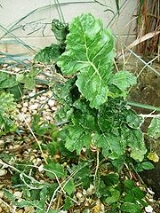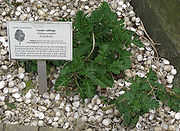
Lundy cabbage
Encyclopedia

Endemic (ecology)
Endemism is the ecological state of being unique to a defined geographic location, such as an island, nation or other defined zone, or habitat type; organisms that are indigenous to a place are not endemic to it if they are also found elsewhere. For example, all species of lemur are endemic to the...
to the island of Lundy
Lundy
Lundy is the largest island in the Bristol Channel, lying off the coast of Devon, England, approximately one third of the distance across the channel between England and Wales. It measures about at its widest. Lundy gives its name to a British sea area and is one of the islands of England.As of...
off the southwestern coast of Great Britain
Great Britain
Great Britain or Britain is an island situated to the northwest of Continental Europe. It is the ninth largest island in the world, and the largest European island, as well as the largest of the British Isles...
, where it is sufficiently isolated to have formed its own species, with its endemic insect pollinators. The Lundy cabbage Coincya wrightii grows only on the eastern cliffs and slopes of the island and nowhere else in the world and is a protected species. It reaches up to a metre in height and with its yellow flowers (seen from May to August) it looks a little similar to oil seed rape. Although it is a member of the cabbage family, it tastes unpleasant – it has been described as "triple-distilled essence of Brussels sprout
Brussels sprout
The Brussels sprout is a cultivar of wild cabbage grown for its edible buds. The leafy green vegetables are typically 2.5–4 cm in diameter and look like miniature cabbages. The sprout is Brassica oleracea, in the "gemmifera" group of the family Brassicaceae...
".
The Lundy cabbage is unique in that two species of beetles that feed on it – the Lundy cabbage flea beetle and the Lundy cabbage weevil – also occur nowhere else in the world. The number of Lundy cabbages varies from year to year. Grazing by goats, sheep and rabbits is a problem, along with suppression by the invasive alien Rhododendron
Rhododendron
Rhododendron is a genus of over 1 000 species of woody plants in the heath family, most with showy flowers...
bushes that are spreading across the island.
It is an excellent example of isolation on an island leading to the production of unique species. Another United Kingdom example is that of the Arran Whitebeams, a group of tree species occurring only on the Isle of Arran
Isle of Arran
Arran or the Isle of Arran is the largest island in the Firth of Clyde, Scotland, and with an area of is the seventh largest Scottish island. It is in the unitary council area of North Ayrshire and the 2001 census had a resident population of 5,058...
in Scotland. Three tree species evolved there and are found nowhere else. They are the Arran Whitebeam, Sorbus arranensis
Sorbus arranensis
Sorbus arranensis, sometimes referred to as the Scottish or Arran Whitebeam is a species of plant in the Rosaceae family. It is endemic to the island of Arran in Scotland.-Range and habitat:...
, the Bastard Mountain Ash, Sorbus pseudofennica
Sorbus pseudofennica
Sorbus pseudofennica is a species of plant in the Rosaceae family. It is a naturally occurring hybrid caused by the Rock Whitebeam hybridising with the Rowan , then crossing back with S. aucuparia...
, and the Catacol Whitebeam, Sorbus pseudomeinichii
Sorbus pseudomeinichii
Sorbus pseudomeinichii, known as Catacol Whitebeam, is a rare tree endemic to the Isle of Arran in south west Scotland. It is believed to have arisen as a hybrid of the native Rowan and the Cut-leaved Whitebeam which is in turn a Rowan/Arran Whitebeam hybrid...
.

